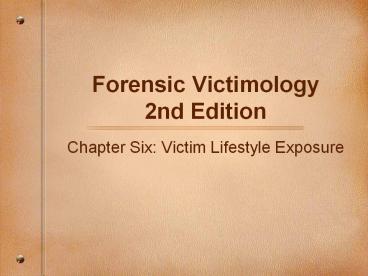Forensic Victimology 2nd Edition - PowerPoint PPT Presentation
Title:
Forensic Victimology 2nd Edition
Description:
Forensic Victimology 2nd Edition Chapter Six: Victim Lifestyle Exposure Victim Lifestyle Exposure Victim exposure is the amount of contact or vulnerability to harmful ... – PowerPoint PPT presentation
Number of Views:165
Avg rating:3.0/5.0
Title: Forensic Victimology 2nd Edition
1
Forensic Victimology 2nd Edition
- Chapter Six Victim Lifestyle Exposure
2
Victim Lifestyle Exposure
- Victim exposure is the amount of contact or
vulnerability to harmful elements experienced by
the victim. - Overall victim exposure is determined by
examining and considering the separate constructs
of lifestyle exposure and situational exposure. - This chapter focuses on lifestyle exposure, which
is related to the frequency of potentially
harmful elements experienced by the victim and
resulting from the victims usual environment and
personal traits, as well as past choices.
3
Lifestyle Exposure - A Theoretical Framework
- Lifestyle factors can influence the overall
possibility of individual harm in three ways - By increasing the victims proximity to, and
interactions with, offenders or those predisposed
towards criminality - By fomenting conditions that create a perceived
conflict with an offender and - By enhancing an offenders perception of victim
vulnerability.
4
Lifestyle Exposure - A Theoretical Framework
- The following criminology theories have proven to
be most useful for identifying and understanding
when a victims lifestyle facilitates
victimization - Victim precipitation
- Lifestyle theory and
- Routine activity theory.
5
Lifestyle Exposure - A Theoretical Framework
- Victim Precipitation
- Victim precipitation refers to the extent to
which a victim plays a role, either knowingly or
unknowingly, in his or her own victimization.
Precipitation can be passive or active. - Passive precipitation occurs when a victim
exhibits some personal characteristics that
unknowingly threatens or encourages the offender.
- Active precipitation refers to those situations
in which the victim directly provokes the
offender.
6
Lifestyle Exposure - A Theoretical Framework
- Lifestyle Theory
- Lifestyle theory argues that some people are more
prone to victimization because their behaviors,
habits, or customs expose them to a greater
frequency of contact with crime and criminals. - This is consistent with the principle of
homogamy, which suggests that individuals are
more exposed to the possibility of victimization
if they frequently associate with, or come into
contact with, members of demographic groups
containing a disproportionate amount of
criminals.
7
Lifestyle Exposure - A Theoretical Framework
- Routine Activity Theory
- The convergence in time and space of three
elements (motivated offenders, suitable targets,
and the absence of a capable guardians) appears
useful for understanding crime rate trends. - The lack of any of these elements if sufficient
to prevent the occurrence of successful
direct-contact predatory crime.
8
Lifestyle Exposure - A Theoretical Framework
- A likely offender is classified as one that is
sufficiently motivated to offend. - This motivation may come from a variety of
factors that can influence victim selection the
process by which an offender chooses or targets a
victim. Victim selection can be classified as - Targeted A targeted victim is the primary
objective of the offense resulting directly from
the offenders motive for committing the crime. - Opportunistic An opportunistic victim is
ancillary to the offense. In such cases, the
offender is motivated by a desire to commit the
offender and the victim is irrelevant.
9
Notable Lifestyle Factors
- There are many lifestyle factors that are
commonly known to increase victim exposure and
vulnerability to harm. The following are examples
of notable lifestyle factors - Attorneys
- Law enforcement
- Prostitutes
- Drug dealers
- Alcoholism and drug addiction
10
Notable Lifestyle Factors
- A number of general traits can also influence a
victims lifestyle exposure. - These include aggressiveness, impulsivity,
self-destructive behavior, passivity, low
self-esteem, and aberrant sexual behavior.
11
Assessing Lifestyle Exposure
- Victim lifestyle exposure is classified for the
purpose of understanding the victims lifestyle
and conditions, in order that exposure may be
fully understood and described to others. - This chapter categorizes victim lifestyle
exposure into extreme-exposure victims,
high-exposure victims, medium-exposure victims,
and low-exposure victims. - Because lifestyle exposure refers to the
frequency of exposure, these categories are
defined by timeframes.
12
Assessing Lifestyle Exposure
- High-exposure victims are those who are exposed
to the possibility of suffering harm or loss more
often than not (e.g., 4-6 days a week). - Medium-exposure victims are those who are exposed
to the possibility of suffering harm or loss less
often than not (e.g., 1-3 days a week). - Low-exposure victims are those who are rarely
exposed to the possibility of suffering harm or
loss (e.g., less than one a week).































